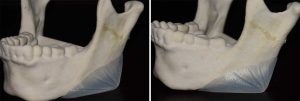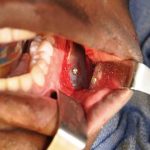1. Who would benefit from jaw angle augmentation?
The shape of one’s jaw is influenced by its horseshoe or U-shape. From angle to angle, the lower jaw (mandible) is a curved bone that is most recognized by its frontal prominence, the chin. But recent trends in men have placed new emphasis on the aesthetics of the jaw angle. From famous actors like Brad Pitt to male models, a prominent jaw angle and jaw line cast an image of masculinity and virility.
While the benefits of chin augmentation have long been recognized for balancing one’s face seen in profile, enhancing the jaw angle helps the face from a frontal perspective. Flaring the jaw angle outward and making the jaw angle more square (angular)makes the entire jaw line a more prominent facial feature.
Weak jaw angles are evident if the lower face is narrow and the cant of the jawline is steep (oblique) rather than more horizontal. If the point of the jaw angle sits above the point of the chin, jaw angle augmentation may be aesthetically beneficial.
2. Are there special implants just for the jaw angle?

3. What are jaw angle implants made of?
There are two basic materials from which jaw angle implants are manufactured. These are silastic (silicone)and Medpor. (polyethylene) Each has some different handling properties which affects the flexibility and stiffness of the implants. While they are all chemically and structurally different, the body sees them all the same way…as a foreign material which it tolerates by surrounding it with scar tissue. (capsule)
Different plastic surgeons may have their preference but that choice is not based on whether it is a ‘better’ implant material. It is a function of what they are familiar with and have had good handling and placement experiences. For me, I am more interested in the shape of the jaw angle implant and how it matches the patient’s jaw angle need. The material from which the jaw angle is made is not as important as its shape.
4. How are jaw angle implants placed?
Access to the jaw angle is done from inside the mouth. This is the most direct route underneath the masseter muscle to where the implant needs to go without creating any external scar. While it is certainly possible to place the implant through an incision right below the jaw angle (as in mandibular fracture repair), this would not only leave a scar but would be more painful and disrupt more muscle tissue.

5. What keeps the jaw angle implant from shifting around after surgery?
Proper positioning of the jaw angle implant is the most important factor in keeping it from moving around after surgery. Silicone, which is very smooth and slick, is much more likely to shift from its intended position than Medpor which has a much higher frictional (gripping) surface. Regardless of the material, I always secure it with a screw when possible to eliminate any doubt about potential implant migration.
6. How painful is jaw angle augmentation after surgery?
Because it is a submuscular (under the muscle) operation, there is some significant discomfort and swelling afterwards. More pertinently, every patient will have some difficulty opening one’s mouth very wide for several weeks after. Known as trismus, this is the direct result of pain and stiffness from the traumatized muscle. When comfortable, patients should start on range of motion exercises to resume their normal oral opening as soon as possible.
7. Can jaw angle implants be done with other facial surgeries?
It is common to do jaw angle augmentation with other facial surgeries. Most commonly, this would be chin and cheek augmentation and rhinoplasty. But it can be done with any other desired facial or body plastic surgery procedure.
Dr. Barry Eppley
Indianapolis, Indiana


